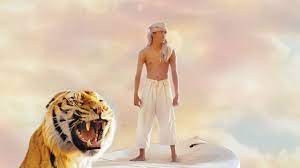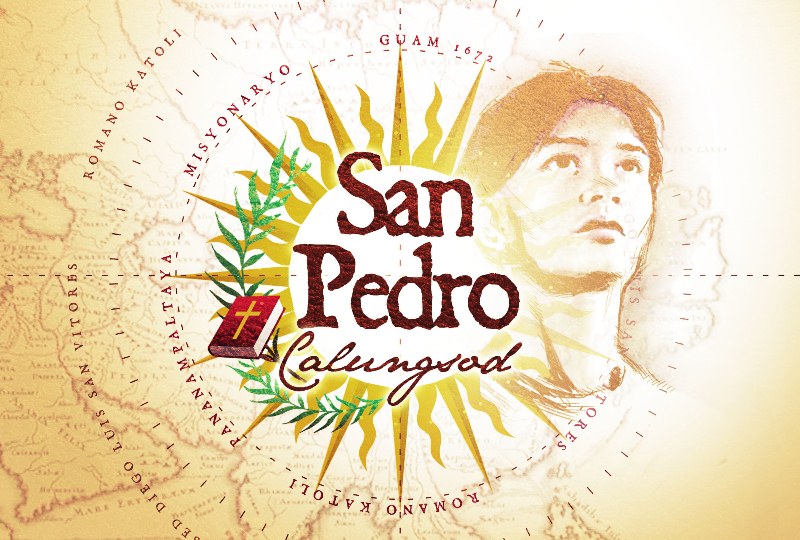Feature Writing : Life of Pi

Life of Pi: Piscine Molitor Patel’s Story of Survival
By: Samantha Beltran
Yann Martel’s novel narrates the story of Piscine “Pi” Molitor Patel, a 16-year-old boy, who has been named lovingly after a Parisian swimming pool. The Life of Pi delineates Pi’s survival and his astounding pursuit of life as changes on his character and personality slowly unravels along with his voyage. There is a sad story behind his name and along the way he decided to change it to “Pi”. His classmates torment him due to the similar pronunciation between the word “pissing” and his name, Piscine. On the latter part of the story, it may be argued that his name has a deeper meaning that shows parallel representation between his experiences and personality.
In the beginning of the novel, the persona’s name is regarded to represent the formula of Pi in the field of Mathematics. His teacher calls him “3.14” – formula of pi in Math. All throughout, Pi portrayed himself as a very religious boy. He was shipwrecked in the Pacific and survives a total of 227 days at the ocean, in a company of a Bengal tiger. The tiger was made known by his father as one of the very treacherous animals in the zoo. His father instilled the inkling about tigers, so that, Pi, as a child would not go too near cages of tigers.
It is a kind of novel that introduces its protagonist as nobody else but the persona. In the first hundred pages of the book, it was narrated that Pi’s childhood was formed in India, and is full of charm. He grew up in his father’s zoo that is why he has a keen understanding of animals. He mentioned that animals are very sensitive when it comes to their territory – that no one including the same specie as them would be exempted once they think they are being trapped.
This novel of Martel is evangelical in character. Its approach to readers is not centered on one religion alone. It unites all religion of any kind. It is just amazing on how it brings a reader closer to God or even believe that He exists – that it is normal to doubt in the midway of our lives because Jesus himself has doubted too before he died.
Moreover, this magical story is made persuasive, vivid and action-packed. It has a careful application of conventional realist techniques that would not let readers become unimaginative while on the verge of reading.
The major theme in the story is the value of the “better story”. According to Pi, “The world is not just the way it is. It is how we understand it”. In the story, Pi defined faith as how we interpret reality. It says that we need to believe in something beyond the seen. That is the real challenge in life that helps us deal with fear. It helps us find a “better story”.
In life, everything about it is a story and we can choose our own kind of anecdote. The author has a point of view that when a story comes very imaginative, it has a better story. It leaves the reader dubiousness whether Pi’s life is real-life fiction or imaginative fiction. Pi presented Japanese men with two stories, one inspired and one crude reality. These men preferred the better story and in the end accepted it. Pi feels that God prefers the better story as well, and so it all goes with Him.
Martel has built his narrative patiently in ensuring that no detail is too tiny for re-evaluation. It shows in the story that Martel has done a vast amount of research specifically botanical and zoological studies. He also observed how the laws of physics and the natural world that relates to reality.
Life of Pi is the story of an Indian boy, one of two sons of the zoo-owner in Pondicherry. Pi has a keen insight to animal behavior garnered from growing up in their company. He also has an innate passion on various religious activities. In his early teens, his family abandons the zoo and sells off all the animals and went aboard on a Japanese cargo ship en route to Canada.
In the middle of the night, Pi was the only one who got saved when the ship got broken and jammed in the middle of the Pacific Ocean. The rest of the book narrates all his fantastic experiences and adventures during his more than two hundred days in a keel before he reaches the watersides of Mexico.
Pi Patel, the persona of this epoch-making narrative does not state the ending away over the Pacific Ocean in the company of not only a Bengal tiger, but together with a hyena and orangutan. Pi has introduced himself since the beginning of the book as a boy who has grown to maturity, pursued university degrees in religion and zoology. These were made possible with the guidance of the people who works in their company, which is the zoo in Pondicherry. He had also raised a family of his own where a little suspense about his fate as a hero has taken place.
The story has obviously the nature of a first person approach or narrative where the persona has lived so to tell the tale, be it on his voyage on the open sea with the company of man eating tigers or marooned on some island. Pi has also used some sort of trickery, “by the time you have read this I will be dead” or “I put this manuscript in this bottle”. Certain words that would move readers to relate better in the storytelling. It makes the story more engaging to readers. Although, Martel as seen in the narrative, was not only after suspense.
Moreover, Pi as the persona is a clever one. In the confines of his lifeboat, he has managed to build the idea of marking his territory in keeping it free from the beasts who attempts to share with him. He also has a humble approach because his outlook on life is what saves him – his faith. The miraculous scene is somewhat similar to the story of Noah’s ark in the Bible. The survival of an Indian boy can only be attributed to some kind of a supreme being or a divine intervention, especially if one is prone to believe having a strong faith from the start. While, the value of religiosity is perhaps the very notable value of Pi’s character even before he leave his hometown in Pondicherry going to Canada with the remains of their zoo. There is enough wonder and truth in religion for Pi. As a young boy, he was born a Hindu but has chosen to be baptized a Christian and follow the religion Islam as well. For some children with the same age, they play cricket bats and soccer balls, while Pi is occupied with prayer rugs, crosses and statues of Ganesha. What makes the story or even the persona amazing is how he recognizes three religions and does not become biased on one alone. His pursuit of one faith need not interfere with the pursuit of the others. It makes the readers closer to God.
In addition, it becomes a testimony to people who lacks understanding or belief on God. Miraculous events are just evidence that there is a Supreme Being who is capable of doing such things in the world. It happens in the everyday course of life. Pi does not have the intention to lay importance of what is divine, but rather give an emphasis of His existence and to be aware of what is too often taken for the commonplace like asserting all that we see comes from nothing less than the divine work of God. As humans, God, the Supreme Being, also creates us. Every little thing that we hear, see or feel were made by Him. According to Pi’s father, it is neither the tiger nor the orangutan that is the most dangerous animal in the world, but man. Humans tend to lose sight of all miraculous things nature has to offer because we experience it so often. What is needed is some violent event like the shipwreck for us to be awakened and see the miracle that is in the life all around us.
Pi has discovered the mere essential that unifies all things, including religion and science. For him, religion is light. It illuminates and makes you see the brighter side of things and does not really contradicts science just like what we were taught. As a matter of fact, it completes science. On the other hand, science too is another kind of religion that has faith in an order and unifying principle, something that is to be embraced like all others.
From Pi’s experience back in high school, he decided to change his name to Pi because his schoolmates were mispronouncing his name. Another violent event that transpired Pi into embracing the bad times in his life is the moment when his family died on a shipwreck and he was left with a Bengal tiger and other zoo animals. This experience served as a message to him that while there is goodness, there is also evil. But, it does not justify the fact that man must question evil or God because it is for man to find a way to live with that evil, while understanding that he is not the center of all creation. Pi wants to know God and become near Him. The hardship of the voyage in the Pacific Ocean symbolizes the journey that people usually have towards God. Along the way, there are circumstances that will test how strong our faith is.
However, there was a striking moment in the beginning of the story when Pi’s father was introducing the wild animals one by one to his son. Pi has only known that his father intentionally did not feed one of his tiger. So, he asked one of the caretakers of the zoo to bring a goat in the tiger’s cage. Pi, as a young boy, was not used in seeing blood and animals getting killed. He saw the very moment the tiger ate the goat. He remained wondering why the tiger needs to do it and so he asked his mother why his father has to let the goat be murdered and eaten by the angry tiger. According to his father, he would not let any animal harm his sons. He let the goat be eaten by the tiger so that his children would always remember not to go near wild animals in the zoo. That is the love of a father to his children.
Pi provided readers the chance to learn much about animal behavior – flight distances, aggression, social hierarchy – that later on explained Pi’s survival strategies while shipwrecked at the Pacific Ocean. The theory about the lion-tamer in a circus ring had been useful in Pi’s survival at the sea. He convinced the tiger that he is the super-alpha male as he marks the boundary of his territory on the boat with urine and fierce-quaking stares.
His mere existence at sea is a miracle that foreshadowed by his spiritual life on land. Pi is a certified creature of faith and a believer of God and His creation. He portrayed joy and hope on the lifeboat, as well as horror, tense and breathless boredom as well. Prayers give him the feeling of elation while stranded in the lifeboat.
Although, this work of Martel has a genre of fiction writing, the idea on religion makes it all the more interesting especially to those people who are being misled by their doubt on religion. Pi showed that nothing is impossible if only faith is stronger than fear. Challenges might break us as a person but if our God is at the center, we can overcome almost everything even the most impossible. That is when miracles occur, when we open our eyes to see it, and open our hearts to feel it. Sometimes, the things are overwhelming us and in which we tend to forget the Supreme Being behind them.
The part when Pi loses his family at the lifeboat is very heartbreaking. He portrayed a role of being strong because he believes that behind every pain, there is hope. All the learnings he had learned from his father were applied when he was left with a very dangerous animal, a Bengal tiger. His survival story while on the lifeboat emphasizes the experiences that people go through when searching for the Supreme Being. As a narrator, it was also shown that it is normal to doubt, and that even Jesus Christ has doubted too before died because He thought he was forsaken in saving the sins of man.
Why not choose to believe that the “better story” is that God really exists even if there is no way to prove that He really exists. This makes the book very appealing to the readers. Although in one of the chapters, Pi shed his opinion towards atheists and agnostics. For him, he still believes that atheists are capable of believing in God for they have always constituted faith in their life – faith in science rather than God –, which Pi believes could not be possible.
Moreover, Pi’s philosophy on freedom is being able to practice it with one’s time, space and relations. Animals and anyone whose survival is consistently being threatened do not have the luxury of being free. Pi has been prolonged in fighting for survival, wherein he was restricted of freedom and brings him down to the level of animals when he pees to transmit the message that the boat is his territory.
There is a connection between his two majors, Zoology and Religion. In these two fields, he sees that there is a tendency on humans towards being self-centered, which is dangerous. In religion, people tend to have lack of faith in God, while zoology may lead to cruel treatment of innocent animals. The cruelty of animals was seen by Pi when his father let the goat be eaten by the tiger.
All the life teachings that came from Pi’s father were made useful while Pi was in the lifeboat fighting for his own survival. All the things he learned from their Pondicherry zoo came flashing back to his memory. The way wild animals hate being dominated by humans and that their territory is the only thing they fight for. There are certain distances to each and every animal in the wild that needs to be followed by men so that there should not be any war between them.
One of the highlights in the story is when the father of Pi posted a trivia on their zoo that men are said to be the dangerous animal of all. That is also one of the things that made Pi stronger at the Ocean. His father made him realize that he is stronger than any other animals so there is no reason for him to be scared. His father portrayed a very important role in the novel, which is similar to God. God is there to give strength whenever we are undergoing some difficulties in life. In the story, Pi’s father supplied his son all the things that he might need in times of challenges.
Pi Patel, a religious boy who was transformed to Christianity think that there is a “better story” if everything is God-centered. That miracles do happen everyday.






